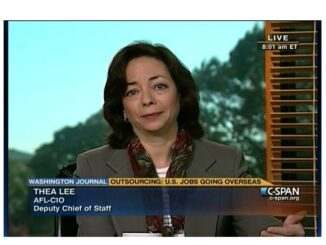
Reprinted from The New York Times by Karen Weise and on April 16, 2021.
… For some workers at the warehouse … the minimum wage of $15 an hour is more than they made in previous jobs and provided a powerful incentive to side with the company. Amazon’s health insurance, which kicks in on the first day of employment, also encouraged loyalty, workers said. …
Other workers said in interviews that they or their co-workers did not trust unions or had confidence in Amazon’s anti-union message that the workers could change the company from within. Often, in explaining their position, they echoed the arguments that Amazon had made in mandatory meetings, where it stressed its pay, raised doubts about what a union could guarantee and said benefits could be reduced if workers unionized. …
Stuart Appelbaum, the president of the retail workers union that led the organizing effort, cited several factors to explain the loss beyond Amazon’s anti-union efforts.
He pointed to the high rate of turnover among employees, estimating that up to 25 percent of Amazon workers who would have been eligible to vote in early January had left by the end of voting in late March — potentially more than the company’s entire margin of victory. Appelbaum surmised that people who had left would have been more likely to support the union because they were typically less satisfied with their jobs. …
Inside the Alabama Amazon Union Drive: An Interview with Joshua Brewer, Lead Organizer
Reprinted from Labor Notes by Luis Feliz Leon and Joshua Brewer on April 17, 2021.
Joshua Brewer: The initial starting point is that there were workers who said that a large amount of their co-workers needed help, and that they were hurting and confused with Covid season, late last summer. That’s where a lot of our campaigns begin, is workers reaching out to the union. They were prepared to put in the work, and then they definitely didn’t let us down. They worked very hard.
Labor Notes: What were some of the barriers to having more of those interactions?
Early on, and continuing throughout the campaign, we had in-person meetings almost daily, and sometimes multiple times a day, with a dozen or so workers and [poultry worker/organizer] Michael “Big Mike” Foster and myself in the union hall. The barrier was with just larger groups, throughout the pandemic. You can’t have 200 people in the union hall, like I have for a contract fight or for a traditional organizing campaign. With a campaign being run in the pandemic, it was about how often can we have meetings. There was a lot of micro-meeting, a lot of smaller-group meeting, trying to get those things done in a way that was safe and also attractive.
I’ve read some things that said that there wasn’t a lot of in-person meetings [on the campaign]. That’s actually incorrect. There was a ton of in-person meetings, there just wasn’t a lot of large in-person meetings, which certainly hurts any campaign, because so much of that excitement and that movement energy comes from that. …
And with Amazon’s flooding the unit like they did, a lot of employees were hired in December—thousands of employees that were hired while we were already three to four months into this campaign, because Amazon wanted to expand the unit. …
EPI: How Amazon Gerrymandered the Union Vote—and Won
Reprinted from The Economic Policy Institute by Lynn Rhinehart on April 15, 2021.
“In all of the coverage about how Amazon and its relentless anti-union campaign defeated the union organizing drive at its fulfillment center in Bessemer, Alabama,” writes Lynn Rhinehart for The Economic Policy Institute, “one key feature of Amazon’s campaign deserves highlighting—namely, Amazon’s countless tactics to try and delay the vote and dilute the union’s support by adding thousands of workers to the bargaining unit who hadn’t previously been involved in the organizing drive. This common tactic, which is straight out of the standard union avoidance playbook, unquestionably played a significant role in defeating the organizing drive. Yet the tactic is perfectly legal under our current labor law. The Protecting the Right to Organize (PRO) Act would put a stop to this tactic and put voting decisions back in the hands of workers and the National Labor Relations Board (NLRB). …
Slate: What Amazon Got Away With
Reprinted from Slate by Grace Pezzella and Sejal Singh on April 13, 2021.
“Amazon may think it’s done in Bessemer, Alabama, but Bessemer isn’t done with Amazon,” write Grace Pezella and Sejal Singh in Slate. “Last week, the vote on whether to unionize the company’s warehouse in the Birmingham suburb ended with a win for Amazon, with workers voting 2-1 against joining a union. But now the company is facing allegations that it illegally interfered with the historic campaign. The National Labor Relations Board, the federal agency charged with enforcing labor law, will likely find that Amazon flouted federal labor law and may order a redo of the election. But even if Amazon follows the law next time, Amazon workers won’t get a free and fair chance to vote on unionizing—because federal labor law is so broken that employers can and do legally rig union elections against their own workers.
“To start a union, workers have to show that a majority of their co-workers want to join—usually through an NLRB-supervised ‘representation election.’ These elections are supposed to be free and fair. But in reality, they’re more like the kinds of elections run by a Tammany Hall mob boss (or sought by Georgia Republicans). When workers announce plans to unionize, employers like Amazon respond with a relentless, no-holds-barred campaign of intimidation, anti-union propaganda, and retaliation. The company faces dozens of federal allegations from facilities around the country for firing workers who organized walk-outs demanding the company adopt COVID-19 safety best practices, sending the message that workers who spoke out for any union effort could expect to lose their jobs during a pandemic and economic crisis. The company surveils workers who organize and recently even posted job listings for ‘intelligence analysts’ to monitor ‘labor organizing threats.’
“The National Labor Relations Act, the federal law governing unions and workplace organizing, is supposed to protect workers’ right to organize for better wages and working conditions. But the NLRA hasn’t been updated in decades, while right-wing judges and politicians have steadily chipped away at the law’s protections. Today, many of Amazon’s worst union-busting tactics are effective, intimidating, and mostly legal. …






